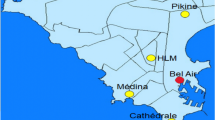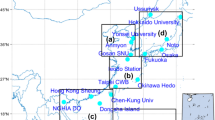Abstract
Carbon monoxide (CO) emission inventory data are crucial for air quality control. However, the emission inventories are labor-intensive and time-consuming and generally have large uncertainties. In this study, we developed a new regional data assimilation system (TracersTracker) for estimating the surface CO emission flux from continuous mixing ratio observations using the proper orthogonal decomposition (POD)-based four-dimensional variational (4D-VAR) data assimilation method (POD-4DVar) and a coupled regional model (Weather Research and Forecasting model (WRF) with the Models-3 Community Multi-scale Air Quality (CMAQ) model). This system was applied to estimate CO emissions in Xuzhou city, China. An experiment was conducted with the continuous hourly surface CO mixing ratio observations from 21 monitoring towers in January and July of 2016. The experimental results of the system were examined and compared with the continuous surface CO observations (a priori emission). We found that the retrieved CO emission fluxes were higher than the a priori emission and were mainly distributed in urban and industrial areas, which were 104% higher in January (winter) and 44% higher in July (summer).







Similar content being viewed by others
References
Altaf MU, Ambrozic M, McCabe MF, Hoteit I (2016) A study of reduced-order 4DVAR with a finite element shallow water model. Int J Numer Methods Fluids 80(11):631–647
Attia A, Ştefănescu R, Sandu A (2017) The reduced-order hybrid Monte Carlo sampling smoother. Int J Numer Methods Fluids 83(1):28–51
Caiazzo F, Ashok A, Waitz IA, Yim SHL, Barrett SRH (2013) Air pollution and early deaths in the United States. Part I: quantifying the impact of major sectors in 2005. Atmos Environ 79:198–208
Cao Y, Zhu SC (2010) Current situations of environmental air quality and countermeasures for pollution in Xuzhou. Environmental Science & Technology
Cao Y, Zhu J, Navon IM, Luo Z (2007) A reduced-order approach to four-dimensional variational data assimilation using proper orthogonal decomposition. Int J Numer Methods Fluids 53(10):1571–1583
Chen, B., Kan, H., Chen, R., Jiang, S., & Hong, C. (2011) Air Pollution and Health Studies in China-Policy Implications 61(11):1292–1299
Constantinescu EM, Sandu A, Chai T, Carmichael GR (2006) Ensemble-based chemical data assimilation I: general approach. Q J R Meteorol Soc 128:1–21
De Foy B, W. L. M. Z., Grutter M, A. R. A. L. (2007) Modelling constraints on the emission inventory and on vertical dispersion for CO and SO2 in the Mexico City Metropolitan Area using Solar FTIR and zenith sky UV spectroscopy. Atmos Chem Phys 7:781–801
Elbern H, Schmidt H, Talagrand O, Ebel A (2000) 4D-variational data assimilation with an adjoint air quality model for emission analysis. Environ Model Softw 15(6):539–548
Elbern, H., Strunk, A., Schmidt, H., & Talagrand, O. (2007) Emission rate and chemical state estimation by 4-dimensional variational inversion 7:1725–1783
Gabrielle Pe Tron CGBK, Valery Yudin JMLJ (2002) Inverse modeling of carbon monoxide surface emissions using CMDL network observations. J Geophys Res 107:1–23
Gou T, Sandu A (2011) Continuous versus discrete advection adjoints in chemical data assimilation with CMAQ. Atmos Environ 15:1–37
Greally BR, Manning AJ, Reimann S, McCulloch A, Huang J, Dunse BL (2007) Observations of 1,1-difluoroethane (HFC-152a) at AGAGE and SOGE monitoring stations in 1994–2004 and derived global and regional emission estimates. J Geophys Res 112:D6308
Gurjar BR, Jain A, Sharma A, Agarwal A, Gupta P, Nagpure AS, Lelieveld J (2010) Human health risks in megacities due to air pollution. Atmos Environ 44(36):4606–4613
Hakami A, HenzeDK, Seinfeld JH, Singh K, Sandu A, Kim S, Byun D, Li Q (2007) The adjoint of cmaq. Environ Sci Technol 41(22):7807–7817
Kilmont ZS (2002) Anthropogenic emissions of non-methane volatile organic compounds in China. Atmos Environ 36:1309–1322
Kim H, Kim HM, Kim J, Cho C (2018) Effect of data assimilation parameters on the optimized surface CO2 flux in Asia. Asia-Pac J Atmos Sci 54(1):1–17
Kurokawa J, Yumimoto K, Uno I, Ohara T (2009) Adjoint inverse modeling of NOx emissions over eastern China using satellite observations of NO2 vertical column densities. Atmos Environ 43(11):1878–1887
Lu S, Lin HX, Heemink AW, Fu G, Segers AJ (2015) Estimation of volcanic ash emissions using trajectory-based 4D-Var data assimilation. Mon Weather Rev 144:575–589
Ma YT (2007) The compilation of vehicle emission inventory in Pearl River Delta region and its uncertainty analysis. Peking University, Beijing
Maione M, Giostra U, Arduini J, Belfiore L, Furlani F, Geniali A, Mangani G, Vollmer MK, Reimann S (2008) Localization of source regions of selected hydrofluorocarbons combining data collected at two European mountain stations. Sci Total Environ 391(2–3):232–240
Manning AJ, Ryall DB, Derwent RG (2003a) Estimating European emissions of ozone-depleting and greenhouse gases using observations and a modeling back-attribution technique. J Geophys Res 108(14):4405
Manning AJ, Ryall DB, Derwent RG, Simmonds PG, O'Doherty S (2003b) Estimating European emissions of ozone-depleting and greenhouse gases using observations and a modeling back-attribution technique. Journal of Geophysical Research Atmospheres 108(D14):10–23
MEPC (2017) 2016 report on the state of the environment in China
Ng MK, Zhu Z (2018) Sparse matrix computation for air quality forecast data assimilation. Numerical Algorithms
T. Ohara, H. A. J. K. (2007) An Asian emission inventory of anthropogenic emission sources for the period 1980–2020. Atmos. Chem Phys (7):4419–4444
Pan XL, Kanaya Y, Wang ZF, Tang X, Takigawa M, Pakpong P, Taketani F, Akimoto H (2014) Using Bayesian optimization method and FLEXPART tracer model to evaluate CO emission in East China in springtime. Environ Sci Pollut Res 21(5):3873–3879
Park S, Lee S, Lee HW (2014) Assimilation of wind profiler observations and its impact on three-dimensional transport of ozone over the Southeast Korean Peninsula. Atmos Environ 99:660–672
Park S, Kim D, Lee S, Lee HW (2016) Variational data assimilation for the optimized ozone initial state and the short-time forecasting. Atmos Chem Phys 16(5):3631–3649
Peng Z, Zhang M, Kou X, Tian X, Ma X (2015) A regional carbon data assimilation system and its preliminary evaluation in East Asia. Atmos Chem Phys 15:1087–1104
Qian S, Lv X, Cao Y, Shao F (2016) Parameter estimation for a 2D tidal model with POD 4D-VAR data assimilation. Math Probl Eng 2016:1–14
Quélo D, Mallet V, Sportisse B (2005) Inverse modeling of NOx emissions at regional scale over northern France: preliminary investigation of the second-order sensitivity. J Geophys Res 110(D24)
Rivier L, Ciais P, Hauglustaine DA, Bakwin P, Bousquet P, Peylin P et al (2006) Evaluation of SF6, C2Cl4, and CO to approximate fossil fuel CO2 in the Northern Hemisphere using a chemistry transport model. Journal of Geophysical Research Atmospheres 111(D16):21–43
Ryall DB, Derwent RG, Manning AJ, Simmonds PG, O'Doherty S (2000) Estimating source regions of European emissions of trace gases from observations at Mace Head. Atmos Environ 35:2507–2523
Saide P, Osses A, Gallardo L, Osses M (2009) Adjoint inverse modeling of a CO emission inventory at the city scale: Santiago de Chile’s case. Atmospheric Chemistry and Physics Discussions 9(2):6325–6361
Saroj Kumar Sahu GBNP (2015) High resolution emission inventory of NOx and CO for mega City Delhi, India. Aerosol Air Qual Res 15:1137–1144
Siade AJ, Putti M, Yeh WWG (2010) Snapshot selection for groundwater model reduction using proper orthogonal decomposition. Water Resour Res 46(8):1–24
Stohl A, Seibert P, Arduini J, Eckhardt S, Fraser P, Greally BR, Lunder C, Maione M, Mühle J, O'Doherty S, Prinn RG, Reimann S, Saito T, Schmidbauer N, Simmonds PG, Vollmer MK, Weiss RF, Yokouchi Y (2009) An analytical inversion method for determining regional and global emissions of greenhouse gases: sensitivity studies and application to halocarbons. Atmos Chem Phys 9(5):1597–1620
Tian X, Feng X (2015) A non-linear least squares enhanced POD-4DVar algorithm for data assimilation. TELLUS SERIES A-DYNAMIC METEOROLOGY AND OCEANOGRAPHY 67:25340
Tian X, ZhengHui X (2009) An explicit four-dimensional variational data assimilation method based on the proper orthogonal decomposition: theoretics and evaluation. Sci China Ser D Earth Sci 52(2):279–286
Tian X, Xie Z, Dai A (2008) An ensemble-based explicit four-dimensional variational assimilation method. J Geophys Res 113(D21124)
Tian X, Xie Z, Liu Y, Cai Z, Fu Y, Zhang H, Feng L (2014) A joint data assimilation system (Tan-Tracker) to simultaneously estimate surface CO2 fluxes and 3-D atmospheric CO2 concentrations from observations. Atmos Chem Phys 14(23):13281–13293
Wang KY, Lary DJ, Shallcross DE, Hall SM, Pyle JA (2001) A review on the use of the adjoint method in four-dimensional. Q J R Meteoml SOC 127:2181–2204
Zhang L, Constantinescu EM, Sandu A, Tang Y, Chai T (2008) An adjoint sensitivity analysis and 4D-Var data assimilation study of Texas air quality. Atmos Environ (23):1–25
Zheng J, Zhang L, Che W, Zheng Z, Yin S (2009) A highly resolved temporal and spatial air pollutant emission inventory for the Pearl River Delta region, China and its uncertainty assessment. Atmos Environ 43(32):5112–5122
Funding
This research was funded by the international partnership program of the Chinese Academy of Sciences (Grant #131A11KYSB20170025), research grants (O88RA901YA) funded by the State Key Laboratory of Resources and Environment Information System, and a research grant (41771114) funded by the National Natural Science Foundation of China.
Author information
Authors and Affiliations
Corresponding author
Ethics declarations
Conflicts of interest
The authors declare that they have no conflict of interest.
Additional information
Responsible editor: Gerhard Lammel
Publisher’s note
Springer Nature remains neutral with regard to jurisdictional claims in published maps and institutional affiliations.
Rights and permissions
About this article
Cite this article
Lu, L., Chen, B., Guo, L. et al. A regional data assimilation system for estimating CO surface flux from atmospheric mixing ratio observations—a case study of Xuzhou, China. Environ Sci Pollut Res 26, 8748–8757 (2019). https://doi.org/10.1007/s11356-019-04246-7
Received:
Accepted:
Published:
Issue Date:
DOI: https://doi.org/10.1007/s11356-019-04246-7




